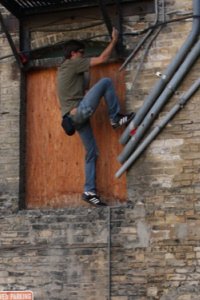Parkour has taken the world by storm and is something of a phenomenon. These days anywhere you go you will see young kids jumping across roof tops, running up flat walls, flipping over cars and generally risking life and limb to defy the laws of gravity. While it might look rather amazing, it’s also something that not everyone can take part in – especially as you get older and your knee joints and spine start to give way.

Fortunately though, parkour is not the only way you can enjoy leaping across an urban landscape like Batman, and if you want to take it a little slower while still getting the same kind of exhilaration then you might find that ‘buildering’ is more to your tastes. Here we will look at what buildering is, and how to get started.
What Is Buildering?
You could consider buildering to be the thinking man’s parkour, or alternatively just an urban version of free running. Here the idea is not to rush from location to location and do jumps and flips, but rather to scale buildings and landmarks vertically with more consideration for technique and scale than for flow and style.
In fact the word buildering is a portmanteau inspired by rock climbing and specifically the ‘bouldering’ aspect of rock climbing which involves climbing boulders and rocks without ropes. Like bouldering, buildering has a very strategic element, and it’s all about solving ‘puzzles’ by working out how a seemingly flat surface can be climbed using simple climbing techniques.
Buildering has its origins in rock climbing, but also in ‘night climbing’ which has been practiced for years under cover of darkness by undergraduates at the universities, and the similar ‘roof climbing’ that preceded even this. There have been several famous builderers who are well known throughout online communities such as Alain Robert who climbed the world’s tallest building in Dubai in 2011, and ‘SpiderDan’ AKA Dan Goodwin or ‘SkyScraperMan’ who started scaling buildings in the 1980s.
Risks
Of course buildering is a highly risky activity and particularly when practiced without ropes. For this reason it is also frowned upon by the law and practitioners will often have encounters with local law enforcement.
To practice buildering safely and legally there are organized events that you can find and charity events that use safety precautions and have permission from landowners. You can of course also practice climbing on your own land, or travel to areas that turn a blind eye to the activities, such as the University of Colorado at Boulder and Tufts University.
Buildering can also be practiced on smaller buildings and landmarks, and it’s also possible to use traversing rather than vertical climbing in order to climb sideways across a wall rather than upward which can help develop climbing skills without including any significant risk. For smaller landmarks and buildings a thick crash mat and a spotter may be enough to counter any significant risk on the part of the practitioner.



